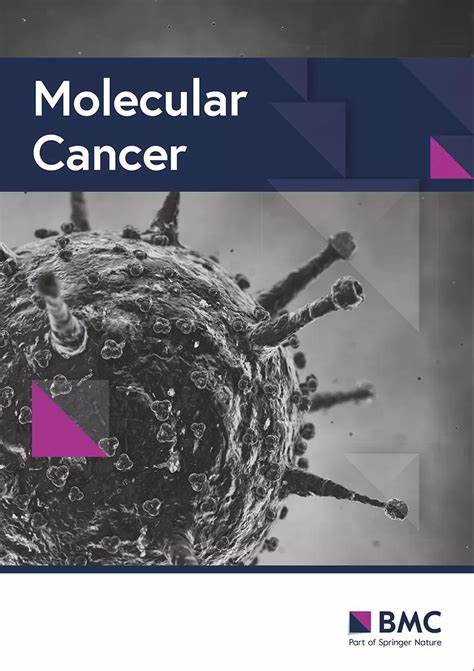Extracellular vesicles: the “Trojan Horse” within breast cancer host microenvironments
IF 33.9
1区 医学
Q1 BIOCHEMISTRY & MOLECULAR BIOLOGY
引用次数: 0
Abstract
Breast cancer represents a significant global health concern among women. The intricate processes and pathways underlying metastasis contribute to the challenging prognoses experienced by some patients. Extracellular vesicles (EVs) are membrane-bound structures characterized by phospholipid bilayers, capable of secretion by a multitude of cell types. The contents of these vesicles encompass a diverse assortment of lipids, proteins, nucleic acids, and cellular metabolites. The tumor microenvironment (TME) comprises a complex network involving tumor cells, non-cancerous cells, and an array of molecules they generate and release. Components include the extracellular matrix, cancer-associated fibroblasts, inflammatory immune cells, tumor-associated vasculature, and EVs discharged by these cellular entities. Within the TME, EVs serve as a mechanism akin to the “Trojan Horse,” exerting significant influence in tumor initiation, progression, metastasis, and responses to therapeutic interventions. EVs originating from tumor cells and associated entities within the TME bolster processes such as stimulating angiogenesis adjacent to tumor sites, establishing pre-metastatic niches in distant anatomical regions, and inducing transformative changes in cancer cells to acquire characteristics promoting invasion, angiogenesis, immune evasion, distant metastasis, and resistance to chemotherapy. Noteworthy is the unique capacity of EVs to traverse biological barriers due to their inherent biocompatibility, rendering them promising candidates for innovative drug delivery systems. This attribute presents an avenue to surmount the constraints of traditional cancer treatments. This scholarly inquiry delves into the pathogenic mechanisms of EVs in breast cancer and delves into prospective therapeutic interventions, offering a groundwork for forthcoming precision-guided therapies tailored to breast cancer.细胞外囊泡:乳腺癌宿主微环境中的“特洛伊木马”
乳腺癌是全球妇女健康关注的一个重大问题。转移的复杂过程和途径导致一些患者的预后具有挑战性。细胞外囊泡(EVs)是一种以磷脂双层为特征的膜结合结构,能够由多种细胞类型分泌。这些囊泡的内容包括各种各样的脂质、蛋白质、核酸和细胞代谢物。肿瘤微环境(tumor microenvironment, TME)是一个复杂的网络,涉及肿瘤细胞、非癌细胞以及它们产生和释放的一系列分子。成分包括细胞外基质、癌症相关成纤维细胞、炎症免疫细胞、肿瘤相关脉管系统以及由这些细胞实体排出的ev。在TME中,ev作为一种类似于“特洛伊木马”的机制,在肿瘤的发生、进展、转移和对治疗干预的反应中发挥着重要的影响。来自肿瘤细胞和TME内相关实体的EVs支持诸如刺激肿瘤部位附近血管生成,在远处解剖区域建立转移前生态位,诱导癌细胞发生转化变化以获得促进侵袭,血管生成,免疫逃避,远处转移和化疗耐药的特性等过程。值得注意的是,由于其固有的生物相容性,电动汽车具有穿越生物屏障的独特能力,使其成为创新药物输送系统的有希望的候选者。这一特性为克服传统癌症治疗的限制提供了一条途径。这项学术研究深入研究了ev在乳腺癌中的致病机制,并深入研究了前瞻性治疗干预措施,为即将到来的针对乳腺癌的精确指导治疗提供了基础。
本文章由计算机程序翻译,如有差异,请以英文原文为准。
求助全文
约1分钟内获得全文
求助全文
来源期刊

Molecular Cancer
医学-生化与分子生物学
CiteScore
54.90
自引率
2.70%
发文量
224
审稿时长
2 months
期刊介绍:
Molecular Cancer is a platform that encourages the exchange of ideas and discoveries in the field of cancer research, particularly focusing on the molecular aspects. Our goal is to facilitate discussions and provide insights into various areas of cancer and related biomedical science. We welcome articles from basic, translational, and clinical research that contribute to the advancement of understanding, prevention, diagnosis, and treatment of cancer.
The scope of topics covered in Molecular Cancer is diverse and inclusive. These include, but are not limited to, cell and tumor biology, angiogenesis, utilizing animal models, understanding metastasis, exploring cancer antigens and the immune response, investigating cellular signaling and molecular biology, examining epidemiology, genetic and molecular profiling of cancer, identifying molecular targets, studying cancer stem cells, exploring DNA damage and repair mechanisms, analyzing cell cycle regulation, investigating apoptosis, exploring molecular virology, and evaluating vaccine and antibody-based cancer therapies.
Molecular Cancer serves as an important platform for sharing exciting discoveries in cancer-related research. It offers an unparalleled opportunity to communicate information to both specialists and the general public. The online presence of Molecular Cancer enables immediate publication of accepted articles and facilitates the presentation of large datasets and supplementary information. This ensures that new research is efficiently and rapidly disseminated to the scientific community.
 求助内容:
求助内容: 应助结果提醒方式:
应助结果提醒方式:


